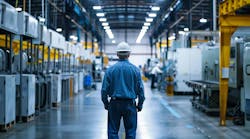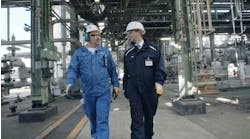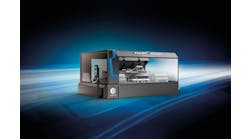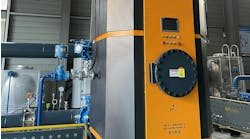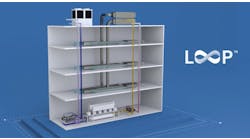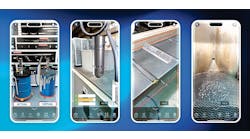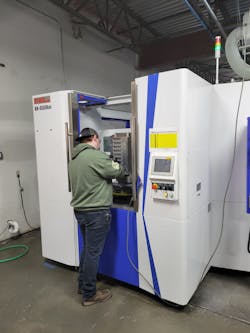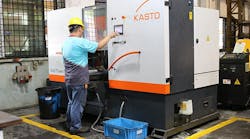Latest from Plant Operations
Many areas of the economy are wrestling with the labor shortage.
For CNC machine shops, the lack of labor is a persistent nemesis—particularly if you run an eight-person shop like Benito Calderon, founder of CAV Manufacturing LLC.
Calderon’s machining journey is a well-trodden path since emigrating to the U.S. from Chile. He started in 1998 by setting up workpieces and fixtures, before gradually moving on to more technical roles like machining, programming, and quality control.
Fully Realizing Floor Space and Throughput
While his roles and shop environments changed, he noticed one constant: the lack of qualified labor is prohibiting growth.
Labor is of the most valuable assets in a shop, and Calderon realized getting the most from your manpower is critical for manufacturers to succeed and grow.
Primed with this mindset, he founded CAV Manufacturing LLC in 2015. The Salisbury, MD-based job shop produces components for the defense, sporting goods, medical, cosmetic, and aerospace industries, among others.
The shop received two contracts to manufacture sporting goods components in late 2021. Calderon had to expand his capacity and wanted equipment that could run with minimal supervision.
He connected with his longtime machine tool dealer, Steve Norcio, president of MTA Company Inc. The two have been working together for almost 25 years.
To get the most out of Calderon’s floor space and help him run unattended longer, Norcio recommended two KIWA KH-4500kai horizontal machining centers, each with six-pallet automatic pallet changers (PC6).
“The only machine covering this base requirement was the multi-pallet KIWA,” Calderon said. “We needed to cover 21 hours of run time, and this machine with six pallets offered the level of automation we were looking for.”
However, as many job shop managers know, sometimes jobs take an unexpected turn.
In Calderon’s case, the would-be customer withdrew the contracts.
But just as quickly as one job left, another arrived. Soon enough, Calderon found himself setting up a new job on his two KIWAs.
Getting the Jobs Done
The first machine was set up to cut a hardened steel part. Using the machine’s tool life management system and the rapid contour programming features allowed CAV to intelligently manage tool cost and part quality. Calderon saw his costs drop dramatically while safely manufacturing parts thanks to lights-out machining.
The second KIWA KH-4500kai was set up to run skinny aluminum parts that were initially fabricated using a laser cutting and press brake. Methods’ engineering team and MTA partnered on the project to design a new machining process on the KIWA using the machine’s high-speed features without deforming the metal.
The result, Calderon said, eliminated two secondary machining operations completed by a third party.
“Coupled with the lights-out manufacturing provided by the KIWA and the PC6, it was a real win-win,” he said.
Initially, Calderon said, he was machining at about 400 cubic inches per minute (ipm) using a 5/8 endmill. Calderon had trouble maintaining those machining conditions on the KIWA and brought his speed down to about 20 ipm.
With the help of some machining specialists from Methods Machine Tools, Calderon could ramp back up to 400 ipm.
“Ken Corklin [Methods’ Director of Channel Sales] and Bernie Otto [Director of Technical Support] helped me find the sweet spot,” Calderon said. “The learning experience brought us good results immediately, otherwise we would have been subcontracting the part.”
At the end of the day, the KIWA reduced Calderon’s production cost by 70% compared to the press brake and laser cutting manufacturing method.
Options Unlock More Capacity
While the KH-4500kai's instant automation piqued Calderon's interest, he found that other aspects of the machine outperformed expectations.
“On the technical side, these machines offered the right amount of tools and superior spindle speed that allows us to machine different materials for efficient high-speed machining,” he said.
By implementing machine options, Calderon increased his lights-out machining capacity. Methods and MTA outfitted one KH-4500kai with a mist collector and coolant-through-spindle (CTS) capability. Calderon said those additions help CAV Manufacturing maintain exceptional accuracy on aluminum and heat-treated steel.
Since he uses redundant tooling, Calderon also utilized the machine's data collection to change tools before they become worn out.
“Redundant tooling data has provided tremendous tool life,” he said. “I’m not spending any more time looking at the spindle for worn-out, broken tools.”
Committing to Growth and Quality
CAV Manufacturing has made other investments as well. The company’s—and Calderon’s—acceptance of modern manufacturing methods and best practices has fueled consistent growth.
In November 2021, the company became an 8(a) certified small business through the U.S. Small Business Administration. The program aids socially and economically disadvantaged small business owners by leveling the playing field for set-aside and sole-source government contracts, aiding in business development, and helping companies navigate various regulations.
If accepted into the program, a business gets assistance for nine years. Some qualifications include demonstrating good character and the potential for success, such as being in business for at least two years.
Achieving that status early on helped CAV reach other goals, supporting continuous growth.
Calderon earned his Six Sigma Black Belt certification and Project Management certification from the Project Management Institute. And in 2021, CAV obtained its ISO 9001:2015 certification.
The company recently began taking on jobs for various firearms, such as the M4/M16, M240/M249, and MK19. CAV has a federal firearm license and manufactures components controlled by the Bureau of Alcohol, Tobacco, Firearms, and Explosives, enabling the company to take on more complex and intensive jobs.
“These certifications were obtained during the toughest times for an emergent small business,” Calderon added.
His tenacity to pursue these goals while maintaining day-to-day operations throughout the pandemic is a testament to finishing complex projects.
He compares CAV’s commitment to growth, excellence, and customer service to the shop’s quality assurance method.
“We don’t just measure a piece with a caliper and call it quality assurance,” Calderon said. “What we do is make sure is process are sound, stable, and reliable by using the best equipment and best engineering.”
MTA’s Norcio said seeing Calderon progress from an entry-level operator to a small business owner using the latest technology for lights-out machining has been a rewarding experience.
“Benito was surely a superstar and the bright light where he was at his past job,” Norcio said. “He came over here from Chile and he was given an opportunity, now he’s living his own American dream.”
